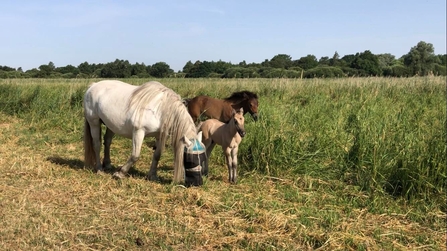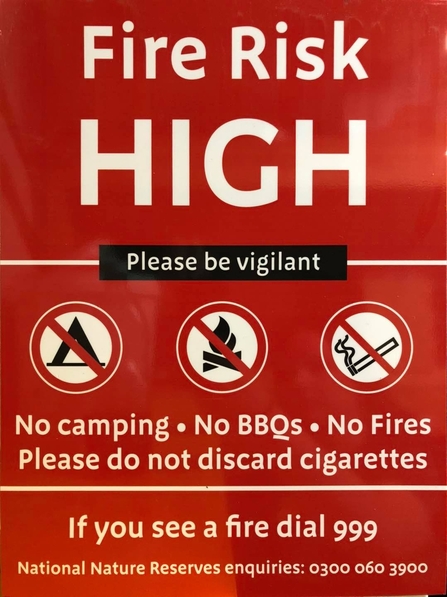
Ponies at Woodwalton Fen - Kate Hawes
Ponies at Woodwalton Fen - Kate Hawes

Ponies at Woodwalton Fen - Kate Hawes
One of the great joys of Spring is its association with new arrivals. Migratory species return after spending winter in sunnier climes, seedlings emerge from the soil, and young animals are born ready to make the most of the relative bounty of the summer.
At Woodwalton Fen this spring, we have had some particularly special new arrivals; five beautiful Highland Ponies. Kyle, Jenna, Nutmeg and two young foals have been hard at work for the past few weeks and will hopefully be helping us out for the rest of the summer too. The ponies join the Angus cows that have been regular summer helpers at Woodwalton Fen for a number of years now.
Grazing with livestock is a great conservation management tool. The ponies create a number of new “microhabitats”: for example hoof prints in soft ground create small areas of bare ground and water, and the dung of the ponies is an important food source for a variety of invertebrates.
Ponies also create a diversity of structures within habitats; trampling vegetation, closely cropping some areas, leaving other areas longer. This greater diversity of structures is a major advantage of using grazing animals over mechanical means to control vegetation; creating this sort of micro variation is really hard with a tractor and mower!
As alluded to above, perhaps the major goal of using grazing is to help maintain habitats in early successional stages. Grazing prevents too much encroachment of more vigorous grasses, scrub and trees, and allows more delicate species that would otherwise be outcompeted to thrive.
However, there are some species which even the toughest grazing animals struggle with. At Woodwalton Fen there are some areas in which Creeping thistle is becoming problematic.
Firstly it must be said that creeping thistle can be a great plant for wildlife. Its vegetative growth feeds a variety of invertebrates, including Painted Lady butterflies. The flowers are extremely nectar rich and therefore a vital food source for a variety of invertebrates. Furthermore, the seeds are eaten by a variety of animals, particularly Goldfinches.
Despite these positive attributes, creeping thistle can be a bit of a thug. It is good at colonising new ground; it grows fast and tall; it spreads quickly underground through adventitious roots; and it can regrow from small root fragments. Creeping thistle can therefore come to dominate areas of grassland, often at the expense of less strongly competitive but perhaps rarer and more desirable species. Here at Woodwalton Fen, where we have a number of scarce plant species, this is particularly concerning. Furthermore, the designation of Woodwalton Fen as a Site of Special Scientific Interest legally requires us to try and maintain the site in “favourable condition”, and in some parts of the site this “favourable condition” entails maintaining more vigorous species like creeping thistle at less than 5% ground cover.
Due to the reasoning outlined above, we try to control the thistle at Woodwalton Fen. Studies done on other sites show the most effective control measures to be combining the right sort of grazing with chemical and mechanical control. Cutting just prior to the plants flowering can help to stop them from spreading and help to reduce their vigour when they regrow. Using herbicide can also be an effective means of control. Herbicide applied with a weedwiper can be especially effective if combined with grazing in the spring, as this reduces the impact of herbicide on plant species other than the thistles. Following up these management techniques with some light grazing in the autumn has been shown to be particularly effective, especially when repeated over a few years.
In the past few weeks we have begun doing some mechanical and chemical control of creeping thistle at Woodwalton, and through the rest of the summer and into autumn we will look to follow this management up in the way outlined above. Hopefully over the coming years we will start to see the results of this management and see benefits to the flora at the south of Woodwalton Fen maintained.
A final reminder too that with the lack of rainfall and extreme temperatures, our peatland is at very high risk of fire at the moment. Peatland fires can be especially difficult to tackle, retreating underground and smouldering for long periods and spreading over large areas. Please be vigilant to any signs of fire and remember there are strictly no fires or heat sources at any time please, including camp fires, camping stoves and BBQs, even if raised off ground.
You can contact us at any time via our Natural England out of hours enquiry line, who will get in touch with local staff - 0300 060 6000.
If you see a fire at any time please call 999 immediately. Thank you!

High Fire Risk sign